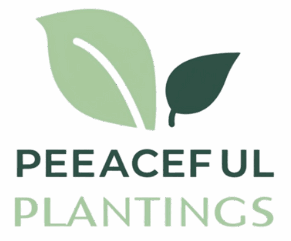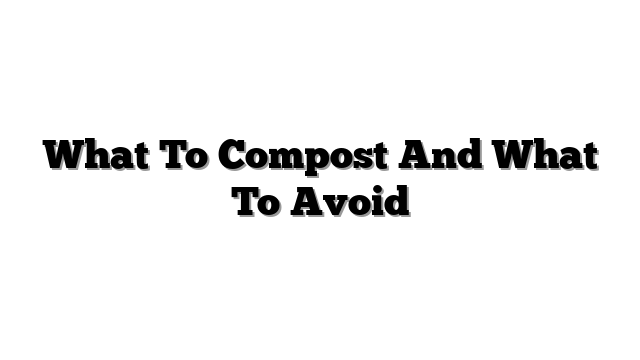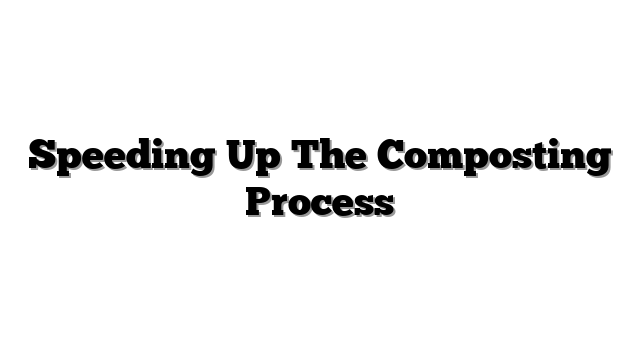What To Compost And What To Avoid
Poor soil makes gardening hard. Dealing with garden waste is tough. Kitchen scraps pile up. You want healthy plants. You need vibrant flowers. Compost helps. It is a natural way. Compost improves your soil. It reduces waste. This is good for the Earth.
This guide helps you. We talk about composting. We show you what to compost. We tell you what to avoid. Learn the basics here. See why composting matters. Get lists of what works. Learn what does not work. Find tips to start. See how to use finished compost. Get ready for a great garden.
The Foundation: Why Composting is Essential for Your Garden
Compost is garden magic. It does more than cut waste. It makes your garden better.
More Than Just Waste Reduction: The Core Benefits of Composting
Compost helps soil. It makes soil better. Soil structure improves. Water drains well. Air gets to roots. Soil holds water too. This is good for plants.
Compost adds food for plants. These are nutrients. Plants use them slowly. You need less fertilizer. This saves money. It helps the Earth.
Good compost has tiny helpers. These are microorganisms. Earthworms love compost. They make soil healthy. They help plants grow strong.
Compost helps fight plant sickness. It keeps bad bugs away. It makes soil pH right. This helps plants eat nutrients.
You make less trash. Kitchen scraps go in. Yard waste goes in. This is waste reduction. It is good for the planet. This is sustainable gardening. It has environmental benefits.
Experts agree. Compost is key. “Healthy soil grows healthy plants,” many say. Compost gives soil life.
A recent study showed this. Gardens using compost had fewer pests. Plants were stronger. This is a simple step. It gives big results.
Understanding the Magic: How Decomposition Works
How does waste become compost? Tiny living things do the work. Bacteria are there. Fungi are there. They eat the waste. This is decomposition.
Air is important. The pile needs air. This is aeration. Water is needed too. Not too dry. Not too wet. Just right.
Materials break down. Some are “Greens.” These have lots of nitrogen. Kitchen scraps are Greens. Grass clippings are Greens.
Some are “Browns.” These have lots of carbon. Leaves are Browns. Shredded paper is Brown. You need a mix. This is the carbon-nitrogen ratio. We talk more later.
Different ways exist. Hot composting is fast. Cold composting is slow. Vermicomposting uses worms. It works for small spaces.
Composting fits new trends. More people garden organically. Organic gardening uses no chemicals. Compost is perfect for this. Native plants need healthy soil. Compost helps them. Small gardens use containers. Compost makes potting mix better. It is part of gardening now. It is a good practice for 2025.
The “Yes” List: What You Can Compost for Nutrient-Rich Soil
Many things become compost. They make soil rich. They become nutrients for plants.
Kitchen Scraps That Are Composting Gold
These are often “Greens.” They add nitrogen.
- Fruit peels. Apple peels work. Banana peels work.
- Vegetable scraps. Carrot tops work. Potato peels work.
- Coffee grounds. Used coffee filters too.
- Tea bags. Check they are not plastic.
- Eggshells. Crush them first.
- Bread. Small pieces work. Avoid oily bread.
- Grains. Cooked rice works. Avoid oily rice.
- Nut shells. Most work. Avoid walnut shells.
These break down easily. They add good stuff. They feed the tiny helpers.
Garden Waste: Turning Yard Trimmings into Black Gold
This is often “Browns.” They add carbon.
- Grass clippings. Do not use grass with weed killer.
- Leaves. Shred them if you can. They break faster.
- Yard trimmings. Small branches work. Chop them up.
- Old plants. Dead flowers work. Old vegetable plants work. Make sure they were not sick.
- Weeds. Put them in before they make seeds. Hot compost kills seeds better.
- Pine needles. Use a small amount. Too many make soil acidic.
This yard stuff becomes useful. It turns into soil food.
Household Items You Didn’t Know You Could Compost
Surprising things can go in.
- Shredded newspaper. Avoid shiny paper. Avoid colored ink.
- Cardboard. Tear it up. Remove tape. Remove labels.
- Paper towels. Only if clean. No grease. No chemicals.
- Napkins. Same rule as paper towels.
- Hair. Your hair works. Pet hair works.
- Nail clippings. Your nails work.
- Cotton clothes. Only pure cotton. Tear it up. No fake fabric.
- Wool clothes. Only pure wool. Tear it up. No fake fabric.
- Wood ash. From clean wood fires. Use a little bit. Not too much.
Cut big things into small pieces. This helps them rot faster. Decomposition happens quicker.
The “No” List: What You Must Avoid Composting and Why
Some things are bad for compost. They cause problems. Do not put these in.
Health Hazards and Pest Attractors
These things smell bad. They bring unwanted visitors. They can have bad germs.
- Meat. Any kind of meat. Bones too.
- Dairy products. Milk is bad. Cheese is bad. Yogurt is bad.
- Fats. Lard is bad. Butter is bad.
- Grease. Cooking grease is bad.
- Oils. Cooking oil is bad.
- Oily foods. Salad dressing is bad. Pizza crust with oil is bad.
These attract rats. They attract flies. They smell very bad. They can make you sick. They have pathogens.
Pet waste is bad. Dog poop is bad. Cat poop is bad. It has bad germs. It has parasites. These make you sick. (Poop from plant-eating animals is okay. Cow poop works. Horse poop works. Chicken poop works.)
Human waste is bad. It has same risks as pet waste.
Materials That Won’t Break Down (Or Will Harm Your Compost)
Some things just sit there. They do not become compost. Some hurt the pile.
- Sick plants. Plants with diseases. They spread sickness. Your compost gets sick. Your garden gets sick.
- Weeds with seeds. Seeds will grow. Your garden will have more weeds. Hot compost might kill them. It is a risk.
- Treated wood. Wood from old decks. Wood from old fences. It has chemicals.
- Sawdust from treated wood. Chemicals are in it.
- Coal ash. From burning coal. It has heavy metals.
- Charcoal ash. From grilling. It can have bad stuff.
These ruin your compost. They make it unsafe. They do not break down right.
Beware of Chemicals and Contaminants
Keep bad stuff out. Chemicals hurt good microbes. They make compost toxic.
- Plastic. Any plastic. It never rots.
- Styrofoam. It is plastic foam. It never rots.
- Fake fabrics. Polyester clothes. Nylon clothes. They do not rot.
- Shiny paper. Magazine pages are bad.
- Heavily printed paper. Ink can have metals.
- Thermal paper. Receipt paper is an example. It has chemicals.
- Pesticides. Bug killers are bad.
- Herbicides. Weed killers are bad.
- Household cleaners. Soap is okay. Strong cleaners are not.
- Colored sawdust. From painted wood. From treated wood. It has chemicals.
Do not guess. If you are not sure, leave it out. It is safer this way. You keep your compost clean. You protect your garden.
Getting Started: Setting Up and Managing Your Compost System
Ready to start? It is not hard. You need a place. You need materials. You need to manage it.
Choosing the Right Spot and System (Bins, Piles, and Beyond)
You need a spot for your compost. Choose a good place.
Some people use a compost bin. A bin holds the pile. It looks neat. Many kinds exist. Plastic bins work. Wood bins work.
Some use an open compost pile. Just a pile on the ground. It is simple. It needs more space.
Tumblers work too. They are bins on a stand. You turn them easily. They compost faster.
Vermicomposting uses worms. It is for kitchen scraps. It works inside. It is good for small homes.
Where should it go? Near your garden is good. Near your kitchen is good. Near a water hose is good. Some sun is okay. Some shade is okay. Keep it away from your house. This helps with smells.
Balancing Your “Greens” and “Browns”: The Carbon-Nitrogen Ratio
This is important. You need a mix. You need “Greens.” These are wet and fresh. Kitchen scraps are Greens. Grass clippings are Greens. They have nitrogen.
You need “Browns.” These are dry and woody. Leaves are Browns. Shredded paper is Brown. They have carbon.
The tiny helpers need both. They need nitrogen for energy. They need carbon for building blocks.
A good mix is key. Too many Greens? The pile smells bad. It gets slimy. Too many Browns? The pile stays dry. It breaks down slowly.
Try mixing 2 parts Browns. Add 1 part Greens. This is a good start. Mix them by how much space they take up. This helps decomposition.
Maintaining Your Pile: Aeration, Moisture, and Temperature
Your pile needs care.
Add materials in layers. Or mix them well. This helps air flow.
Air is very important. Turn your pile sometimes. This is aeration. Use a fork or a special tool. Turning adds air. Air helps microbes work. No air means bad smells. Anaerobic decomposition happens.
Water is needed too. Your pile should feel like a wet sponge. Not dripping wet. Not dusty dry. Squeeze a handful. A few drops should come out. Add water if dry. Add dry Browns if too wet.
Temperature matters. Hot composting works fast. It kills weed seeds. It kills bad germs. It gets hot inside. Cold composting is slower. It does not get hot. It might not kill seeds or germs.
Start simple. Add scraps and leaves. Mix them sometimes. Water if it looks dry. It will work.
The Payoff: Using Your Finished Compost
You waited. You managed the pile. Now you have black gold. This is finished compost.
Knowing When Your Compost is Ready
How do you know it is ready? It looks dark brown. It is crumbly. It smells like earth. It smells good. You cannot see the old scraps. No banana peels. No leaves. It looks like soil.
You can screen it. Use a screen with holes. This removes big pieces. Put big pieces back in the new pile.
Putting Your Black Gold to Work in the Garden
Your finished compost is useful. It helps plants grow.
Mix it into garden beds. Do this before planting. It improves soil structure. It adds nutrients.
Put it around plants. This is top dressing. It is like mulch. It adds nutrients slowly. Do this for flowers. Do this for trees. Do this for bushes.
Add it to potting soil. Mix it for containers. Plants in pots need good soil. Compost helps drainage. It adds food. This helps plant growth.
Make compost tea. Put compost in water. Let it sit. Use the liquid. It is liquid fertilizer.
Spread it on your lawn. It improves the soil. It makes grass healthier. This is soil improvement.
How much should you use? Add a few inches to beds. Mix it in. For pots, mix 1 part compost to 2 or 3 parts potting mix. Use a thin layer around plants.
Gardeners love finished compost. It makes a difference. It makes plants happy.
Your Composting Questions Answered (FAQ)
People ask questions about composting. Here are some answers.
How long does compost take? It depends. Hot piles finish faster. Maybe a few months. Cold piles take longer. Maybe a year or more.
Why avoid meat or dairy? They attract pests. Think rats and flies. They smell bad. They can have bad germs.
Can I compost weeds and sick plants? It is risky. Weed seeds can live. Sick plants spread disease. Hot composting kills some. It is safer to leave them out.
What are ‘Greens’ and ‘Browns’? Greens are fresh and wet. Kitchen scraps are Greens. They add nitrogen. Browns are dry and woody. Leaves are Browns. They add carbon. You need both for decomposition.
How do I know compost is ready? It looks dark. It feels crumbly. It smells like good soil. You cannot see the old stuff.
Start Composting Today for a Healthier Garden and Planet
Composting is powerful. It helps your garden. It helps the Earth.
Knowing what to compost helps. Knowing what to avoid is key. This makes good compost.
Compost helps soil health. It helps plant growth. It supports sustainable gardening.
Try composting. Start small. Use a bin. Use a pile. See the benefits.
We hope this helps. Use these gardening tips. Make your soil better. Grow strong plants. Share your compost story. Explore our other articles. Learn more about organic gardening. Find more soil improvement tips.






